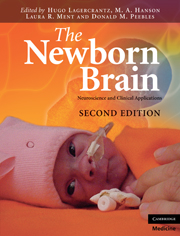Book contents
- Frontmatter
- Contents
- List of contributors
- Preface to the First Edition
- Preface to the Second Edition
- 1 Reflections on the origins of the human brain
- Section 1 Making of the brain
- 2 The molecular basis of central nervous system development
- 3 Holoprosencephaly and microcephaly vera: perturbations of proliferation
- 4 Neuronal migration
- 5 The neonatal synaptic big bang
- 6 Neurotrophic factors in brain development
- 7 Neurotransmitters and neuromodulators
- 8 Glial cell biology
- Section 2 Sensory systems and behavior
- Section 3 Radiological and neurophysiological investigations
- Section 4 Clinical aspects
- Section 5 Follow-up
- Section 6 Consciousness
- Index
- Plate section
- References
3 - Holoprosencephaly and microcephaly vera: perturbations of proliferation
from Section 1 - Making of the brain
Published online by Cambridge University Press: 01 March 2011
- Frontmatter
- Contents
- List of contributors
- Preface to the First Edition
- Preface to the Second Edition
- 1 Reflections on the origins of the human brain
- Section 1 Making of the brain
- 2 The molecular basis of central nervous system development
- 3 Holoprosencephaly and microcephaly vera: perturbations of proliferation
- 4 Neuronal migration
- 5 The neonatal synaptic big bang
- 6 Neurotrophic factors in brain development
- 7 Neurotransmitters and neuromodulators
- 8 Glial cell biology
- Section 2 Sensory systems and behavior
- Section 3 Radiological and neurophysiological investigations
- Section 4 Clinical aspects
- Section 5 Follow-up
- Section 6 Consciousness
- Index
- Plate section
- References
Summary
Malformations of the developing nervous system may arise from disorders primarily affecting the nervous system or arise incidentally as part of multisystemic disorders. More than a century of study preceding the modern era of cellular and molecular biology has established a schema for the basic histogenetic sequences of development that are disrupted by the molecular and cellular biological perturbations which give rise to the most well-known developmental malformations of the brain (Sidman & Rakic, 1982; Caviness et al., 2008). These encompass histogenetic processes ranging from cell proliferation to cellular events involved in elementary pattern formation including migration and postmigratory rearrangements, to the processes of growth and differentiation, including the winnowing of “excess” cells and cell processes. The perturbations arising from genetic mutations are among the most extreme in their consequences for development of the nervous system and for adaptation or even survival of the organism. They have, however, offered penetrating insights into the nature and mechanisms through which genetic regulation governs the cellular and molecular biological processes through which development proceeds.
Our focus over the years has been the proliferative process, the earliest step in the histogenetic sequence. In particular, we have focused on regulation of proliferative mechanisms that give rise to the vertebrate neocortex, with the mouse being our experimental model. Over time, this work has served to inform our parallel interest in disorders of the developing human forebrain as encountered in the clinic.
- Type
- Chapter
- Information
- The Newborn BrainNeuroscience and Clinical Applications, pp. 37 - 54Publisher: Cambridge University PressPrint publication year: 2010



